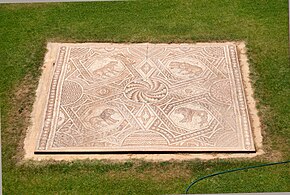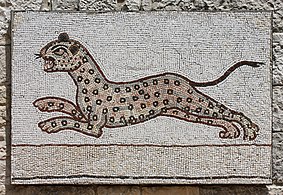
A mosaic is a pattern or image made of small regular or irregular pieces of colored stone, glass or ceramic, held in place by plaster/mortar, and covering a surface. Mosaics are often used as floor and wall decoration, and were particularly popular in the Ancient Roman world.

Beit ed-Dine, also known as Btaddine is a small town and the administrative capital of the Chouf District in the Mount Lebanon Governorate in Lebanon. The town is located 45 kilometers southeast of Beirut, and near the town of Deir el-Qamar from which it is separated by a steep valley. It had 1,613 registered voters in 2010 and its inhabitants are predominantly Christians from the Maronite, Melkite and Greek Orthodox denominations. Beit ed-Dine's total land area consists of 244 hectares and its average elevation is 860 meters above sea level.
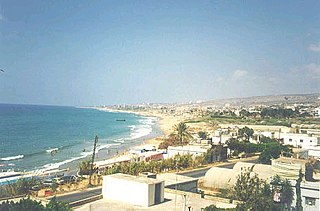
Jieh is a seaside town in Lebanon with an estimated population of 5000, 23 km south of Beirut, in the Chouf District via a 20-minute drive along the Beirut to Sidon highway south of the capital. In Phoenician times, it was known as Porphyreon and was a thriving natural seaport, which still functions today. The town is also known for its seven-kilometre sandy beach, which is a rarity along Lebanon's rocky coastline.

The Great Palace Mosaic Museum, is located close to Sultanahmet Square in Istanbul, Turkey, at Arasta Bazaar. The museum houses mosaics from the Byzantine period, unearthed at the site of the Great Palace of Constantinople.

The Beirut Central District is the historical and geographical core of Beirut, the capital of Lebanon. Also called downtown Beirut, it has been described as the “vibrant financial, commercial, and administrative hub of the country.” It is thousands of years old, with a traditional focus of business, finance, culture, and leisure.

The National Museum of Damascus is a museum in the heart of Damascus, Syria. As the country's national museum as well as its largest, this museum covers the entire range of Syrian history over a span of over 11 millennia. It displays various important artifacts, relics and major finds most notably from Mari, Ebla and Ugarit, three of Syria's most important ancient archaeological sites. Established in 1919, during King Faisal's Arab Kingdom of Syria, the museum is the oldest cultural heritage institution in Syria.
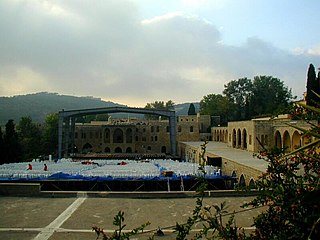
The Beiteddine Festival is an annual summer festival that takes place in Beiteddine Palace in Beiteddine, Lebanon. It was launched amidst war and destruction in the middle of the 80's. It came as an act of faith in Lebanon's cultural specificity and its power of creativity and artistic freedom. It was a call for normality in the middle of the chaos and madness of the civil war. It was established in 1984 with local artistic performances and it gradually started having regional and international performances. Over the years, it has included concerts or performances related to classical music, dance, theatre, opera, jazz, and modern world music.

Beiteddine Palace is an 18th-century palace in Beiteddine, Lebanon, built by Bashir II. The palace hosts the annual Beiteddine Festival and the Beiteddine Palace Museum.
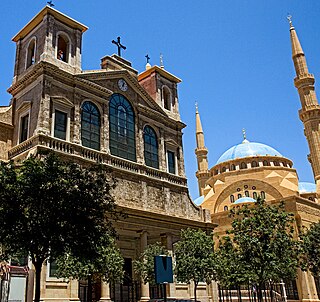
The tourism industry in Lebanon has been important to the local economy historically and comprises a major source of revenue for the country.

Early Byzantine mosaics in the Middle East are a group of Christian mosaics created between the 4th and the 8th centuries in ancient Syria, Palestine and Egypt when the area belonged to the Byzantine Empire. The eastern provinces of the Eastern Roman Empire and its continuation, the Byzantine Empire, inherited a strong artistic tradition from pagan Late Antiquity. The tradition of making mosaics was carried on in the Umayyad era until the end of the 8th century. The great majority of these works of art were later destroyed but archeological excavations unearthed many surviving examples.
Omran Al-Kaysi is an artist, historian and art critic. He currently writes for the daily Lebanese newspaper, Kifaharabi and is a correspondent to a newspaper in Saudi Arabia.

The Antioch mosaics are a grouping of over 300 mosaic floors created around the 3rd century AD, and discovered during archaeological excavations of Antioch between 1932 and 1939 by a consortium of five museums and institutions. About half of the mosaics are now in the Hatay Archaeology Museum in Antakya, with the rest in the Worcester Art Museum, Museum of Fine Arts, Boston, Baltimore Museum of Art, Harvard University and Princeton University Art Museum among others. The mosaics range in design from realistic imagery and scenes to purely geometric patterns.

The Robert Mouawad Private Museum is a private residence in Beirut's Zokak el-Blat quarter that was turned into a museum by the Lebanese businessman Robert Mouawad.

The Stoclet Frieze is a series of three mosaics created by the Austrian painter Gustav Klimt for a 1905-1911 commission for the Stoclet Palace in Brussels, Belgium. The panels depict swirling Tree of life, a standing female figure and an embracing couple.
Shhiim alternatively written as Shheem or Chhim/Chehim is a town in Lebanon which is located 40 kilometres south-east of Beirut.

Konya Archaeological Museum is a state archaeological museum in Konya, Turkey. Established in 1901, it had been relocated twice before moving to its present location in 1962. One of the most prominent displays in the museum is of sarcophagi and other antiquities from the ancient city of Çatalhöyük. Other exhibits relate to the Neolithic, Bronze Age, Iron Age, Classical, Hellenistic, Roman and the Byzantine periods; artifacts consist of ceramic ware, stone and bronze wares, ornaments and inscriptions. Among the objects displayed is a marble sarcophagus of the 3rd century AD, with elaborate relief sculptures depicting the life of Hercules. In the outer open yard of the museum there are a number of small sculptures, sarcophagi, column capitals, and samples of epigraphy.
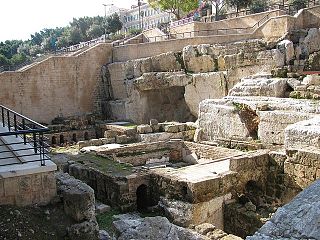
Colonnaded Street is located in downtown Beirut, Lebanon. it was an important street of Roman-era Berytus.

The Mosaic Fragment with Man Leading a Giraffe is a mosaic from the 5th century CE, now held in the Art Institute of Chicago. The piece is Byzantine and originated in northern Syria or Lebanon. Mosaics of this type were commonly used to decorate wealthy family villas.

The Birds Mosaic or Armenian Mosaic, as it is popularly known, or the Musrara (Bird) Mosaic in academic parlance, is an almost perfectly preserved, richly decorated sixth-century mosaic floor from an Armenian mortuary chapel discovered some 300 metres northwest of the Damascus Gate in the Musrara neighbourhood of Jerusalem.


